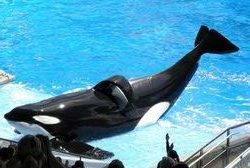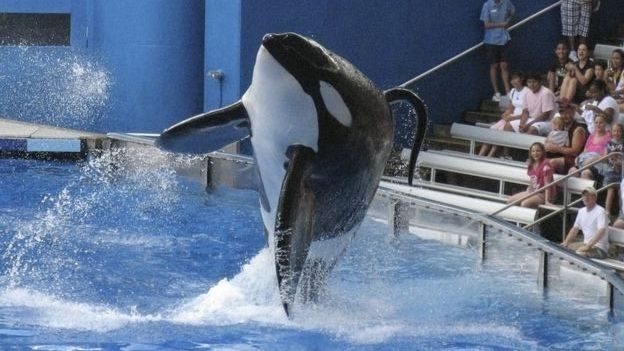Tilikum died this week after three decades in captivity, deprived of all that was enjoyable and natural to him. There's an outpouring of messages on social media expressing sadness at the news of the death of Tilikum, the orca who was the subject of Blackfish, but sadness is not what I feel. I can't be sad that after more than three decades, Tilly is finally out of his misery. No, what I'm feeling is anger – anger that death was the only way he could escape his hellish existence swimming in endless circles in a tiny, barren tank at SeaWorld.
Weighing a colossal 12,500 pounds and measuring nearly seven metres long, he was a giant among giants. According to SeaWorld, he had suffered from a “persistent and complicated bacterial lung infection”. And while a necropsy is still required to determine the official cause of death, we all know that captivity is what killed him. When he was no more than a two-year-old baby, Tilikum was ripped from his ocean home off the coast of Iceland in November 1983. He would never see his family, feel the sea water on his skin or experience freedom again. Instead, he was sold to the highest bidder as though a mere commodity – first to the now-defunct Sealand of the Pacific in British Columbia and then to SeaWorld Orlando in Florida, where he would remain for the next 24 years.
The confinement drove him mad and made him lash out in frustration – and unsurprisingly, he was implicated in three human deaths, most notably that of experienced SeaWorld trainer Dawn Brancheau, whom he scalped and dismembered in 2010 before drowning her in his enclosure. Speaking of the incident, Blackfish producer Tim Zimmermann summed it up best, saying, “He killed three human beings. And yet when you learn about his life story, he does become the victim and you do sympathise with him.” Indeed you do.
Tilikum was deprived for more than three decades of all that was enjoyable and natural to him. Day in and day out, this social, emotional and intelligent animal was prevented from satisfying his basic drives and from engaging in any type of natural behaviour, such as swimming over large distances. He was frequently cut, rammed and raked by other orcas, with whom he had no ancestral, cultural or communication similarities. (In the wild, each family unit, or pod, has its own culture as well as a unique group dialect.) Forced to live in grotesquely small enclosures, he could do nothing but swim in endless circles and perform tricks in exchange for dead fish. And to add insult to injury, he was repeatedly masturbated to produce sperm to artificially inseminate other orcas in order to provide a constant supply of baby orcas for SeaWorld to use or sell.
Seaworld penguin gets wetsuit because she's losing her feathers
His grim existence has changed public opinion about keeping orcas in tanks, and the backlash prompted SeaWorld to stop breeding orcas (even if the news came too late for Tilikum, who was bred 21 times – 11 of his offspring died before he did). While his death in a concrete cell marks the end of his diminished existence as a source of profit for SeaWorld, it is our hope that it also marks the beginning of a new future for animals incarcerated at the abusement park.
Tilikum may be gone, but there's still time for Katina, Kasatka, Ulises and Corky – the other orcas at SeaWorld – to be transferred to sea sanctuaries which can provide them with some semblance of the life that they've been robbed of for so long. If we are to honour Tilikum’s memory, we must stop at nothing to ensure that his death is the last one inside SeaWorld’s walls. That can be his legacy.
∼Orca. Tilikum became a resident of SeaWorld some 25 years ago. He had been born in the waters off Iceland some ten or twelve years previously. In 1983, when it was estimated that he was two or three years old, he was captured near Iceland, then kept for about a year in a holding tank. He then was installed at a marine park in British Columbia called SeaLand of the Pacific, where he was given the name Tilikum, meaning “friend” in the Chinook language. In 1991, Tilikum and two other whales reportedly prevented a trainer from leaving their tank after she fell in, resulting in her death. Tilikum was then transferred to SeaWorld Orlando, where, in 1999, a man illegally entered the park at night and was found dead in the whale's enclosure the next day. An inquest ruled that the 27-year-old had died of hypothermia. In 2010 his trainer died after Tilikum dragged her underwater by her hair as she performed with the whale in front of an audience. The investigation into her death ruled that she died from drowning and traumatic injuries. SeaWorld stated that her death was not an attack, but a terrible accident. Tilikum was removed from the park’s public performances for a year after the incident and new safety rules introduced prohibited trainers from entering the water to perform tricks with the whales. In 2013 he was featured in a controversial documentary the water park insisted was emotionally manipulative and misleading. Tilikum sired 14 calves while he was at SeaWorld Orlando, but the company announced an end to its breeding program and theatrical shows involving killer whales in 2016. In early March of that year, Tilikum was reported to be lethargic, and veterinarians were worried about his health, noting a persistent bacterial lung infection had set in. After extensive treatment stretching to ten months, SeaWorld issued a statement announcing Tilikum's death in early 2017.
Tilikum died this week after three decades in captivity, deprived of all that was enjoyable and natural to him. There's an outpouring of messages on social media expressing sadness at the news of the death of Tilikum, the orca who was the subject of Blackfish, but sadness is not what I feel. I can't be sad that after more than three decades, Tilly is finally out of his misery. No, what I'm feeling is anger – anger that death was the only way he could escape his hellish existence swimming in endless circles in a tiny, barren tank at SeaWorld.
Weighing a colossal 12,500 pounds and measuring nearly seven metres long, he was a giant among giants. According to SeaWorld, he had suffered from a “persistent and complicated bacterial lung infection”. And while a necropsy is still required to determine the official cause of death, we all know that captivity is what killed him. When he was no more than a two-year-old baby, Tilikum was ripped from his ocean home off the coast of Iceland in November 1983. He would never see his family, feel the sea water on his skin or experience freedom again. Instead, he was sold to the highest bidder as though a mere commodity – first to the now-defunct Sealand of the Pacific in British Columbia and then to SeaWorld Orlando in Florida, where he would remain for the next 24 years.
The confinement drove him mad and made him lash out in frustration – and unsurprisingly, he was implicated in three human deaths, most notably that of experienced SeaWorld trainer Dawn Brancheau, whom he scalped and dismembered in 2010 before drowning her in his enclosure. Speaking of the incident, Blackfish producer Tim Zimmermann summed it up best, saying, “He killed three human beings. And yet when you learn about his life story, he does become the victim and you do sympathise with him.” Indeed you do.
Tilikum was deprived for more than three decades of all that was enjoyable and natural to him. Day in and day out, this social, emotional and intelligent animal was prevented from satisfying his basic drives and from engaging in any type of natural behaviour, such as swimming over large distances. He was frequently cut, rammed and raked by other orcas, with whom he had no ancestral, cultural or communication similarities. (In the wild, each family unit, or pod, has its own culture as well as a unique group dialect.) Forced to live in grotesquely small enclosures, he could do nothing but swim in endless circles and perform tricks in exchange for dead fish. And to add insult to injury, he was repeatedly masturbated to produce sperm to artificially inseminate other orcas in order to provide a constant supply of baby orcas for SeaWorld to use or sell.
Seaworld penguin gets wetsuit because she's losing her feathers
His grim existence has changed public opinion about keeping orcas in tanks, and the backlash prompted SeaWorld to stop breeding orcas (even if the news came too late for Tilikum, who was bred 21 times – 11 of his offspring died before he did). While his death in a concrete cell marks the end of his diminished existence as a source of profit for SeaWorld, it is our hope that it also marks the beginning of a new future for animals incarcerated at the abusement park.
Tilikum may be gone, but there's still time for Katina, Kasatka, Ulises and Corky – the other orcas at SeaWorld – to be transferred to sea sanctuaries which can provide them with some semblance of the life that they've been robbed of for so long. If we are to honour Tilikum’s memory, we must stop at nothing to ensure that his death is the last one inside SeaWorld’s walls. That can be his legacy.
∼Orca. Tilikum became a resident of SeaWorld some 25 years ago. He had been born in the waters off Iceland some ten or twelve years previously. In 1983, when it was estimated that he was two or three years old, he was captured near Iceland, then kept for about a year in a holding tank. He then was installed at a marine park in British Columbia called SeaLand of the Pacific, where he was given the name Tilikum, meaning “friend” in the Chinook language. In 1991, Tilikum and two other whales reportedly prevented a trainer from leaving their tank after she fell in, resulting in her death. Tilikum was then transferred to SeaWorld Orlando, where, in 1999, a man illegally entered the park at night and was found dead in the whale's enclosure the next day. An inquest ruled that the 27-year-old had died of hypothermia. In 2010 his trainer died after Tilikum dragged her underwater by her hair as she performed with the whale in front of an audience. The investigation into her death ruled that she died from drowning and traumatic injuries. SeaWorld stated that her death was not an attack, but a terrible accident. Tilikum was removed from the park’s public performances for a year after the incident and new safety rules introduced prohibited trainers from entering the water to perform tricks with the whales. In 2013 he was featured in a controversial documentary the water park insisted was emotionally manipulative and misleading. Tilikum sired 14 calves while he was at SeaWorld Orlando, but the company announced an end to its breeding program and theatrical shows involving killer whales in 2016. In early March of that year, Tilikum was reported to be lethargic, and veterinarians were worried about his health, noting a persistent bacterial lung infection had set in. After extensive treatment stretching to ten months, SeaWorld issued a statement announcing Tilikum's death in early 2017.
Advertisement
Advertisement



